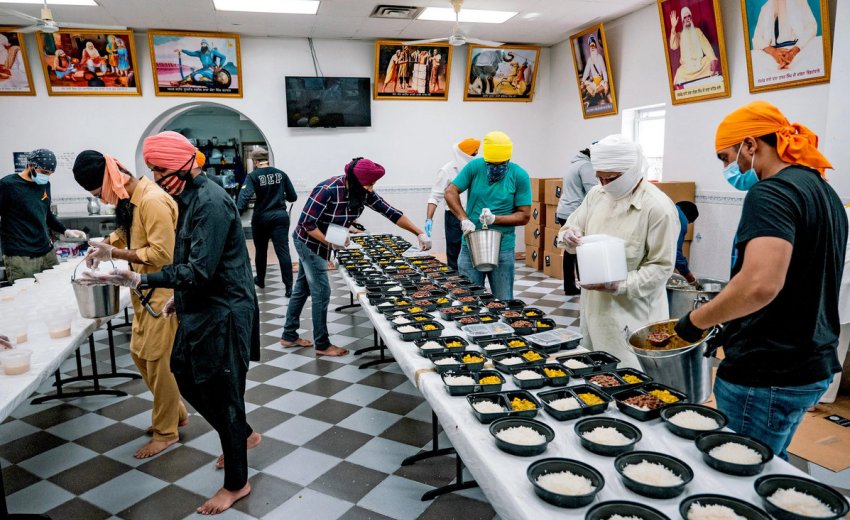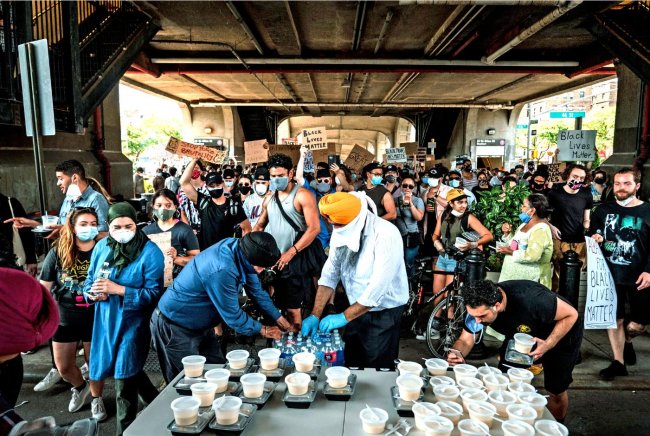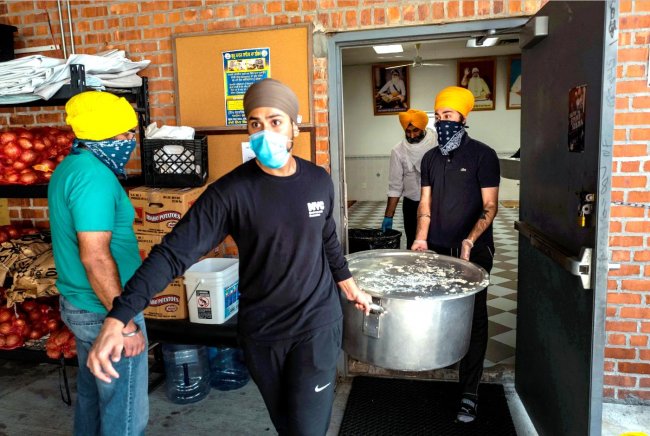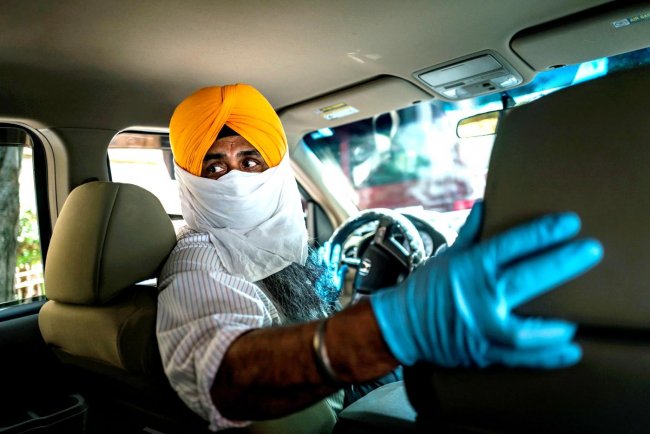Inside a low, brick-red building in Queens Village, a group of about 30 cooks has made and served more than 145,000 free meals in just 10 weeks. They arrive at 4 a.m. three days a week to methodically assemble vast quantities of basmati rice, dal, beans and vibrantly flavored sabzis for New York City hospital workers, people in poverty and anyone else in search of a hot meal.
This isn’t a soup kitchen or a food bank. It’s a gurdwara, the place of worship for Sikhs, members of the fifth-largest organized religion in the world, with about 25 million adherents. Providing for people in need is built into their faith.
An essential part of Sikhism is langar, the practice of preparing and serving a free meal to promote the Sikh tenet of seva, or selfless service. Anyone, Sikh or not, can visit a gurdwara and partake in langar, with the biggest ones — like the Golden Temple in Amritsar, India — serving more than 100,000 people every day.
Since the coronavirus pandemic has halted religious gatherings in most of the country, including langar, gurdwaras like the Sikh Center of New York, in Queens Village, are mobilizing their large-scale cooking resources to meet the skyrocketing need for food aid outside their places of worship.
Some are feeding the protesters marching in outrage over the killings of George Floyd and other black Americans by the police. Last week, a dozen or so volunteers from the Queens center served 500 portions of matar paneer, rice and rajma, a creamy, comforting dish of red beans stewed with tomatoes, and 1,000 bottles of water and cans of soda to demonstrators in Sunnyside. They also offered dessert: kheer, a sweetened rice pudding.
“Where we see peaceful protest, we are going,” said Himmat Singh, a coordinator at the World Sikh Parliament, an advocacy group providing volunteers for the Queens Village efforts. “We are looking for justice. We support this.”
Since the pandemic began, soup kitchens have had difficulty keeping up with demand. Shuttered schools and even fine-dining restaurants are using their kitchens to prepare and serve hot meals. But few other places are as well positioned to handle the sheer scale of assistance required right now as the gurdwaras. Most have large, well-equipped kitchens, a steady stream of volunteers and no shortage of ingredients, thanks to regular donations from community members.
During the last annual Sikh Day Parade in New York, in April 2019, the Queens Village kitchen — which has a walk-in cooler, multiple freezers, 50-liter stockpots and a huge grill that can cook dozens of rotis at once — produced 15,000 meals in a single day.
The Sikhs’ biggest challenge isn’t keeping up with demand. It’s letting people know that they’re here — without making a big show of it or proselytizing, which is forbidden.
Founded in the 15th century in Punjab, India, by the spiritual leader Guru Nanak, Sikhism has an estimated 500,000 followers in the United States and 280 gurdwaras, according to the Sikh Coalition, a civil-rights organization in New York City. One of the most visibly distinctive features of the Sikh practice is the turban — a symbol of the religion’s belief in equality — though not everyone chooses to wear one.
Sikhs in America have been often been prey to bigotry, hate crimes and Islamophobia, particularly since 9/11. A few volunteers said in interviews that before going out to distribute meals, they worried that they might hear ignorant comments. But Santokh Dillon, the president of the Guru Nanak Mission Society of Atlanta, said the people he serves are often more puzzled than prejudiced. Most have never even heard of Sikhism, he said.
When some find out that the meals are free, “They look at us and say, ‘You are kidding, right?’ ”
At least 80 gurdwaras in the United States are now providing food assistance. For many, the transition has been quick and seamless.
This is not just because the infrastructure is already there, said Satjeet Kaur, the executive director of the Sikh Coalition. “The call to action and the responsibility” for helping others is deeply entrenched in the Sikh way of life. Sikhs are expected to donate at least 10 percent of their time or income toward community service.
It took the Gurdwara Sahib of Fremont, Calif., just a few days after suspending religious services in March to set up a meal and grocery delivery program, and a drive-through meal pickup system outside the gurdwara.
Cooks wear gloves and masks, and the kitchen is big enough for workers to stand more than six feet from one another. As at most gurdwaras, the menu changes regularly, but is typically Indian and always vegetarian. (Meat is not permitted in gurdwaras.)
While these Sikh volunteers, known as sevadars, are experts in mass-meal preparation, they aren’t as accustomed to spreading the word. The Fremont kitchen has produced 15,000 to 20,000 meals a day on holidays like New Year’s Eve, said Dr. Pritpal Singh, a member of the gurdwara. But now, the gurdwara is serving just 100 to 150 people each day.
Dr. Singh said he hoped that more people in need would come pick up food. “We could do hundreds of thousands of meals if given the task,” he said.
But with the demonstrations unfolding around the country, Sikhs aren’t waiting for people to come to them any longer. On Tuesday, volunteers from the Gurdwara Sahib attended a protest in Fremont and handed out several hundred bottles of water as a show of solidarity.
On a recent Friday, Gurjiv Kaur and Kiren Singh asked the volunteers at their gurdwara, the Khalsa Care Foundation, in the Pacoima neighborhood of Los Angeles, to prepare meals in the community kitchen that they could take to the protest. The next morning, they and others picked up about 700 containers of pasta with a garlic- and onion-laden tomato sauce and 500 bottles of water from the gurdwara, and set up a tent in Pan Pacific Park. Soon, protesters started arriving at the tent with other donations, like medical supplies, snacks and hand sanitizer.




